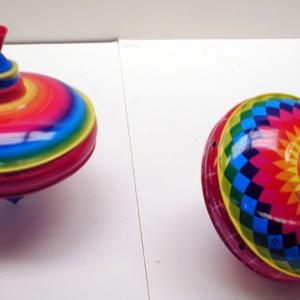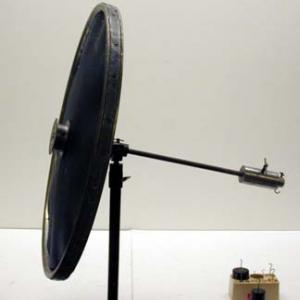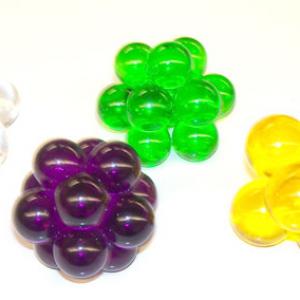College of Liberal Arts & Sciences
1Q50.01 - Precession - Bicycle Wheels, Gyroscopes, and Tops
Do not drop the top off of the lecture bench. Put a couple of drops of oil on the top spindle every year.
Some oiling and adjustment of the bicycle axle may be required. Do not tighten the floor stand to tightly to the shaft of the bicycle wheel as this will prevent the free movement necessary.
It should be noted that the motor is only 12 volts and that we are using a Variac capable of 120 plus volts so that a voltmeter to monitor the voltage may be advisable. The motor driven demonstration also works best with a 100 or 200 gram mass.
The Tippy - Top, old fashion top, and the football will all act in the same manner. When spun the frictional torques will cause all of them to rotate about their statically unstable axis.
The Quark Top is a super precision top that should spin for upwards to 15 minutes if properly balanced.
The "wind top" runs by starting it spinning with your fingers and then gently blowing downward onto the top to bring it up to speed.
Orbital precession can be demonstrated using one of the fiberglass cones.
- William A. (Toby) Dittrich, "Drop Tower Physics II, TPT, Vol. 60, #7, Oct. 2022, p. 605.
- Rod Cross, "Surprising Behavior of Spinning Tops and Eggs on an Inclined Plane", TPT, Vol. 54, # 1, Jan. 2016, p. 28.
- Philip Davidowsky, Michael Rogers, "Debunking a Video on YouTube as an Authentic Research Experience", TPT, Vol. 53, # 5, May 2015, p. 304.
- Rod Cross, "Precession of a Spinning Ball Rolling Down a Inclined Plane", TPT, Vol. 53, # 4, April 2015, p. 217.
- Christian T. Corrao, "The Sakai Spinner: A Paperclip Top", TPT, Vol. 52, # 2, Feb. 2014, p. 122.
- John Cordell, "Correction: John Cordell, "Non-Mathematical Explanation of Precession", TPT, Vol. 50, # 3, Mar. 2012, p. 132.
- John Cordell, "Non-Mathematical Explanation of Precession", TPT, Vol. 49, # 9, Dec. 2011, p. 572.
- Oscar Bolina, "The Precessing Top", TPT, Vol. 38, # 5, p. 312, May 2000.
- Herman Erlichson, "Angular Momentum and Angular Velocity", TPT, Vol. 32, # 5, May 1994, p. 274.
- R. D. Edge, "The Wobbler", TPT, Vol. 28, # 2, Feb. 1990, p. 122.
- Roger Blickensderfer, "The Wheel and the Galilean Transformation", TPT, Vol. 26, # 3, Mar. 1988, p. 160.
- Clifton Bob Clark, Stuart Thomson, "Dynamical Balance and The Rotating Rod - A Personal Demonstration", TPT, Vol. 26, # 4, Apr. 1988, p. 237.
- Richard D. Stepp, "Why Wheels Work", TPT, Vol. 20, # 8, Nov. 1982, p. 551 - 552.
- Thomas B. Greenslade, "Plucker and Fessel Gyroscope (Photo)", AJP, Vol. 79, # 9, Sep. 2011, p. 965.
- Harry Soodak, "A Geometric Theory of Rapidly Spinning Tops, Tippe Tops, and Footballs", AJP, Vol. 70, # 8, Aug. 2002, p. 815.
- James A. Lock, "An Alternative Approach to the Teaching of Rotational Dynamics", AJP, Vol. 57, #5, May 1989, p. 428.
- J. Liesegang and A. R. Lee, "Dynamics of a Bicycle: Non-Gyroscopic Aspects", AJP, Vol. 46, # 2, Feb. 1978, p. 130.
- P. L. Edwards, "A Physical Explanation of the Gyroscope Effect", AJP, Vol. 45, # 12, Dec. 1977, p. 1194.
- P. C. Eastman, "Painless precession", AJP, Vol. 43, #4, April 1975, p. 365.
- J. Higbie, "The Motorcycle as a Gyroscope", AJP, Vol. 42, # 8, Aug. 1974, p. 701.
- A. F. Burr, "Non - Colinearity of Angular Velocity and Angular Momentum", AJP, Vol. 42, # 2, Feb. 1974, p. 100.
- Mu-1, 7, Freier and Anderson, A Demonstration Handbook for Physics.
- M-187, Richard Manliffe Sutton, Demonstration Experiments in Physics.
- M-19f, Wallace A. Hilton, Physics Demonstration Experiments.
- Tik Liem, "The Human Gyroscope", Investigation to Science Inquiry, p. 391.
- "The Spinning Double Sphere", Physics Today, Feb. 2016, p. 72.
- S. B. Lambert et al., "Tracking Earth's Wobbles", Physics Today, August 2006, p. 20.
- George M. Hopkins, "A Scientific Top", Experimental Science, p. 14.
- George M. Hopkins, "The Choral Top", Experimental Science, p. 12.
- Jearl Walker, "The Physics of Spinning Tops, Including Some Far-Out Ones", The Amateur Scientist, March, 1981.
- Martin Gardner, "Paradox on Wheels", Entertaining Science Experiments with Everyday Objects, p. 92.
- Jearl Walker, "1.104, Personalities of Tops", The Flying Circus of Physics Ed. 2, p. 52.
- 2.26, Jearl Walker, "Turning a Car, Bike, and Train", The Flying Circus of Physics with Answers.
- 2.69, Jearl Walker, "Gyroscopic Motion", The Flying Circus of Physics with Answers.
- "295, Turning a Corner", Christopher P. Jargodzki and Franklin Potter, Mad About Physics, p. 119, 253.
- "How Do You Balance a Bicycle?", Mechanics of Solids, Peter J. Brancazio.
- Wizzzer Student Activity Pack, 1999 Duncan Toys.
- Wizzzer Teacher's Guide, 1999 Duncan Toys.
- #125, "Wobbler", Janice VanCleave's 203 Icy, Freezing, Frosty, Cool, and Wild Experiments.
- Prof. Robert Griffith, "Tops of All Kinds", Boys' Useful Pastimes, p. 67.
- Joseph Frick, "#119 - The Gyroscope", Physical Technics: Or, Practical Instructions for Making Experiments in Physics and the Construction of Physical Apparatus with the Most Limited Means", p. 143.
- Dr. Gordon Stables, R.N., C. Stansfeld Hicks, J. N. Maskelyne, Rev. Harry Jones, M.A, Dr. Stradling, Captain Crawley, Rev. A. n. Malan, M.A., F.G.S., and Many Others, "#2 - A Home-Made Humming-Top", The Boy's Own Book of Indoor Games and Recreations, A Popular Encyclopaedia for Boys, p. 374.
Disclaimer: These demonstrations are provided only for illustrative use by persons affiliated with The University of Iowa and only under the direction of a trained instructor or physicist. The University of Iowa is not responsible for demonstrations performed by those using their own equipment or who choose to use this reference material for their own purpose. The demonstrations included here are within the public domain and can be found in materials contained in libraries, bookstores, and through electronic sources. Performing all or any portion of any of these demonstrations, with or without revisions not depicted here entails inherent risks. These risks include, without limitation, bodily injury (and possibly death), including risks to health that may be temporary or permanent and that may exacerbate a pre-existing medical condition; and property loss or damage. Anyone performing any part of these demonstrations, even with revisions, knowingly and voluntarily assumes all risks associated with them.




